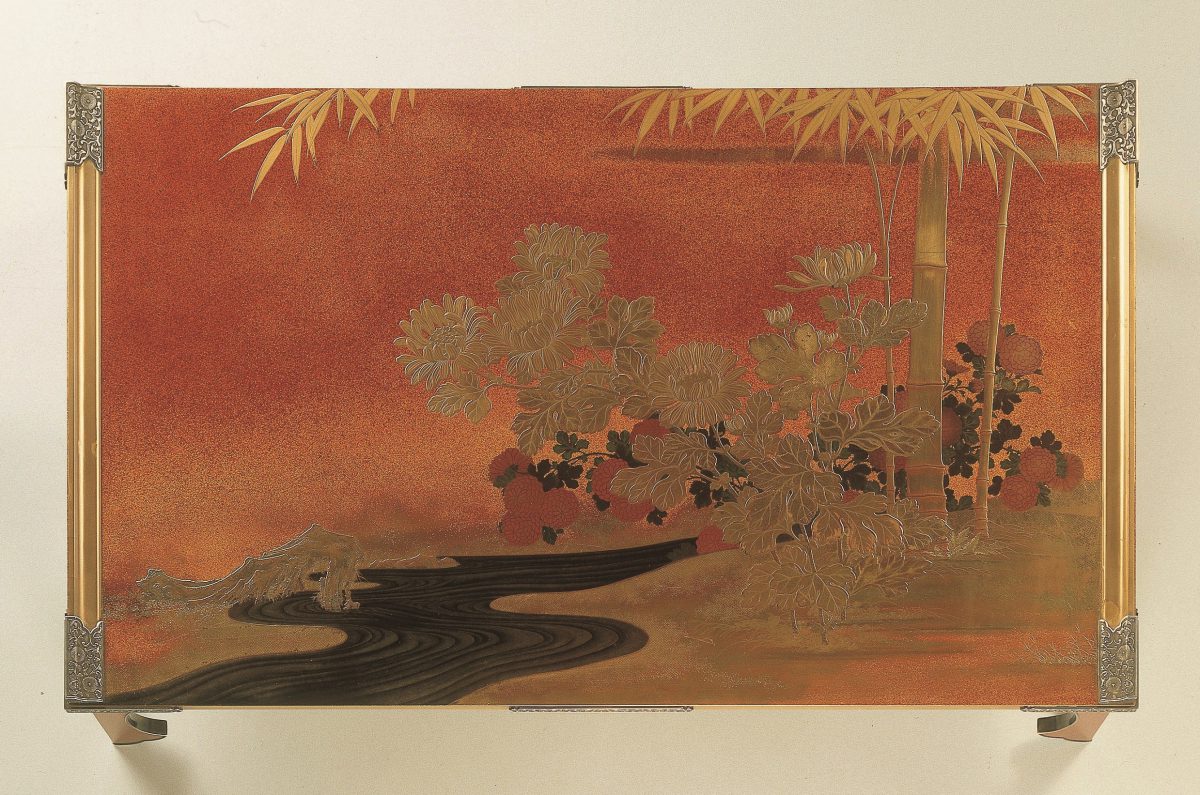



Title: Writing-box and Writing-table
Date: 1904 or earlier
Location: Japan
Materials: wood lacquered in takamaki-e, hiramaki-e, kirikane, nashiji; silver and gold water-dropper; silver fittings
Dimensions: 13 x 36 x 61 cm (writing-table) 5.5 x 24.5 x 26 (writing-box);
Accession Number: L 160
Other Notes:
A matching set of suzuribako and bundai, the suzuribako with rounded corners and an overhanging lid and the bundai with silver fittings. They portray chrysanthemums and bamboo growing by a stream, in gold hiramakie and takamakie, and red, green, and black togidashie, with kirikane details (some of silver on the bundai), on a dense nashiji ground. The inside of the lid of the suzuribako depicts irises growing by a small rock in gold hiramakie and takamakie, with kirikane of gold foil and shell on a nashiji ground. The box contains an ink-stone, a silver water-dropper with gold overlay in the form of two superimposed decorated shikishi papers, an ink-holder, a knife, a skewer, and two brushes, all within nashiji holders with silver fittings. The underside finished in nashiji.
Shirayama Shosai (1853-1923), one of the leading lacquerers of the Meiji and Taisho periods, exhibited works at several world fairs, receiving awards in Paris (1900) and St. Louis (1904). He started his training by studying sword-decoration under Notoya Isaburo before specializing in makie under Kobayashi Kozan, lacquer-carving under Gamo Morikazu, and lacquer-application under Itakura Toyojiro. From 1880 he worked with the Kiritsu Kosho Kaisha (see also M 143), in 1892 he became a professor at the Tokyo Bijutsu Gakko [Tokyo School of Art], and in 1906 he was appointed teishitsu gigeiin [Imperial Artist]. Shosai is especially famous for the quality of his work in togidashie, but he also excelled at elaborate and luxurious gold hiramakie and takamakie in a conservative style. The suzuribako and bundai were exhibited at the Louisiana Purchase Exposition in St. Louis, 1904.
Bibliography:
O. Impey, M. Fairley, J. Earle (eds.), Meiji No Takara: Treasures Of Imperial Japan: Lacquer Vol II, London 1995, cat. 119.
J. Earle, Splendors of Imperial Japan: Arts of the Meiji period from the Khalili Collection, London 2002, cat. 332, p. 450.
Zoom
Close
